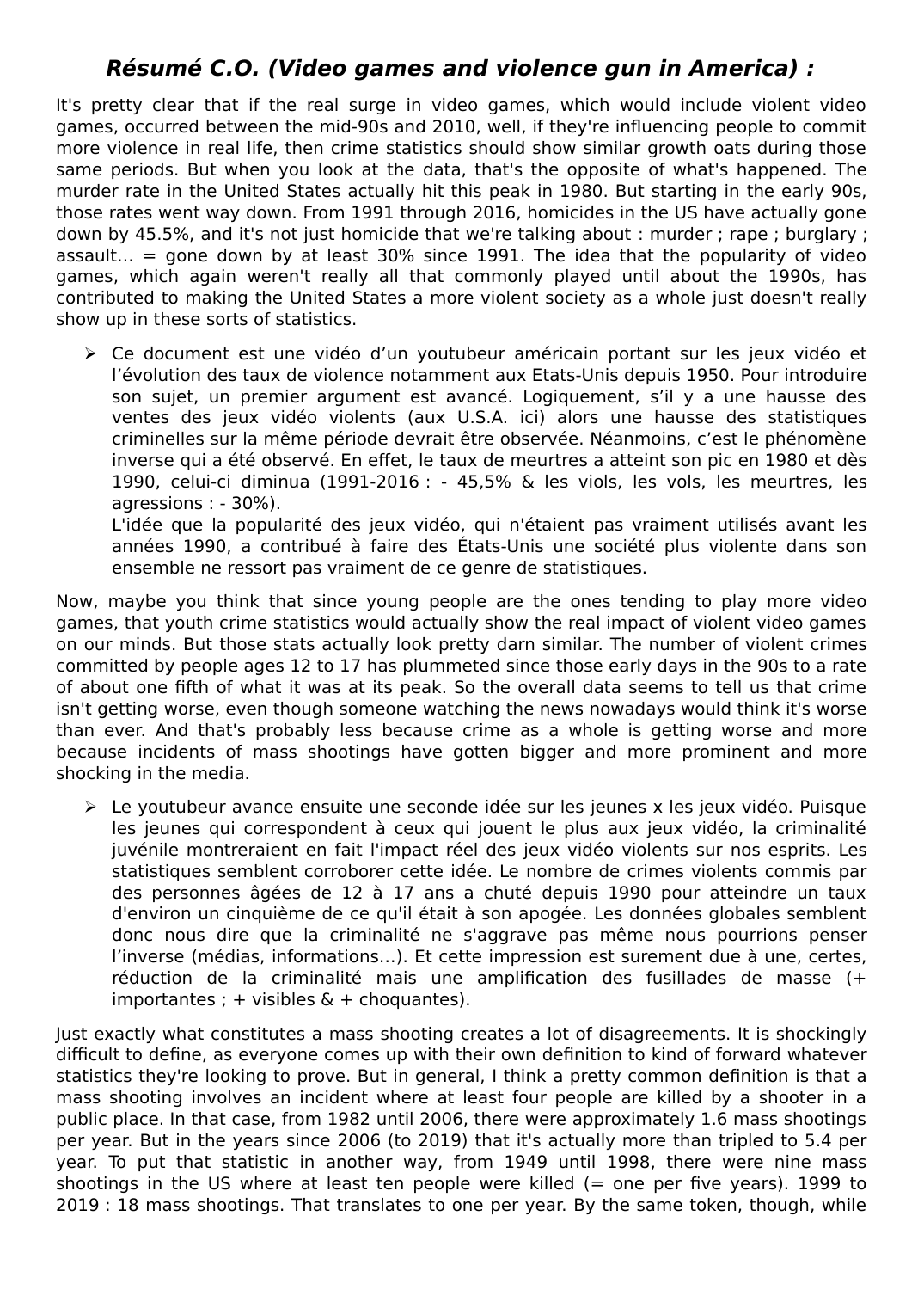Script vidéo sur les jeux vidéos et traduction
Publié le 14/11/2021

Extrait du document
«
Résumé C.O.
(Video games and violence gun in America) :
It's pretty clear that if the real surge in video games, which would include violent video
games, occurred between the mid-90s and 2010, well, if they're influencing people to commit
more violence in real life, then crime statistics should show similar growth oats during those
same periods.
But when you look at the data, that's the opposite of what's happened.
The
murder rate in the United States actually hit this peak in 1980.
But starting in the early 90s,
those rates went way down.
From 1991 through 2016, homicides in the US have actually gone
down by 45.5%, and it's not just homicide that we're talking about : murder ; rape ; burglary ;
assault… = gone down by at least 30% since 1991.
The idea that the popularity of video
games, which again weren't really all that commonly played until about the 1990s, has
contributed to making the United States a more violent society as a whole just doesn't really
show up in these sorts of statistics.
Ce document est une vidéo d’un youtubeur américain portant sur les jeux vidéo et
l’évolution des taux de violence notamment aux Etats-Unis depuis 1950.
Pour introduire
son sujet, un premier argument est avancé.
Logiquement, s’il y a une hausse des
ventes des jeux vidéo violents (aux U.S.A.
ici) alors une hausse des statistiques
criminelles sur la même période devrait être observée.
Néanmoins, c’est le phénomène
inverse qui a été observé.
En effet, le taux de meurtres a atteint son pic en 1980 et dès
1990, celui-ci diminua (1991-2016 : - 45,5% & les viols, les vols, les meurtres, les
agressions : - 30%).
L'idée que la popularité des jeux vidéo, qui n'étaient pas vraiment utilisés avant les
années 1990, a contribué à faire des États-Unis une société plus violente dans son
ensemble ne ressort pas vraiment de ce genre de statistiques.
Now, maybe you think that since young people are the ones tending to play more video
games, that youth crime statistics would actually show the real impact of violent video games
on our minds.
But those stats actually look pretty darn similar.
The number of violent crimes
committed by people ages 12 to 17 has plummeted since those early days in the 90s to a rate
of about one fifth of what it was at its peak.
So the overall data seems to tell us that crime
isn't getting worse, even though someone watching the news nowadays would think it's worse
than ever.
And that's probably less because crime as a whole is getting worse and more
because incidents of mass shootings have gotten bigger and more prominent and more
shocking in the media.
Le youtubeur avance ensuite une seconde idée sur les jeunes x les jeux vidéo.
Puisque
les jeunes qui correspondent à ceux qui jouent le plus aux jeux vidéo, la criminalité
juvénile montreraient en fait l'impact réel des jeux vidéo violents sur nos esprits.
Les
statistiques semblent corroborer cette idée.
Le nombre de crimes violents commis par
des personnes âgées de 12 à 17 ans a chuté depuis 1990 pour atteindre un taux
d'environ un cinquième de ce qu'il était à son apogée.
Les données globales semblent
donc nous dire que la criminalité ne s'aggrave pas même nous pourrions penser
l’inverse (médias, informations…).
Et cette impression est surement due à une, certes,
réduction de la criminalité mais une amplification des fusillades de masse (+
importantes ; + visibles & + choquantes).
Just exactly what constitutes a mass shooting creates a lot of disagreements.
It is shockingly
difficult to define, as everyone comes up with their own definition to kind of forward whatever
statistics they're looking to prove.
But in general, I think a pretty common definition is that a
mass shooting involves an incident where at least four people are killed by a shooter in a
public place.
In that case, from 1982 until 2006, there were approximately 1.6 mass shootings
per year.
But in the years since 2006 (to 2019) that it's actually more than tripled to 5.4 per
year.
To put that statistic in another way, from 1949 until 1998, there were nine mass
shootings in the US where at least ten people were killed (= one per five years).
1999 to
2019 : 18 mass shootings.
That translates to one per year.
By the same token, though, while.
»
↓↓↓ APERÇU DU DOCUMENT ↓↓↓
Liens utiles
- Grand oral maths Comment peut-on démasquer un tricheur dans un jeu vidéo ?
- Quels sont les impacts, positifs et négatifs, de l'organisation des Jeux olympiques ?
- Meeting Jeux RP
- maths: jeux de hasard (GO)
- Grand Oral Maths: Comment les mathématiques nous poussent à ne pas jouer aux jeux d’argent ?


